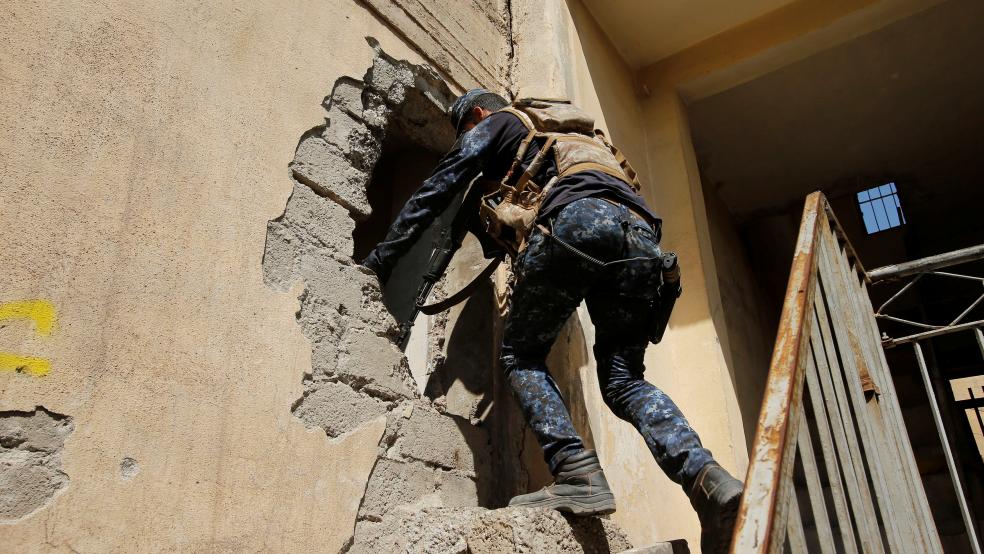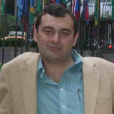A few weeks ago, the US Central Command announced that an air raid had killed an ISIS chemical weapon expert in Mosul. The ISIS operative, Iraqi engineer Mahmoud al-Sabawi, used to work at Saddam Hussein’s chemical weapons program before he joined al-Qaeda in Iraq after the 2003 US led invasion.
The idea that ISIS terrorists have access to chemical weapons brings back images of the genocide inflicted on the Kurds by Saddam Hussein in the late 1980’s. The Halabja Massacre killed up to 5,000 and injured between 7,000 and 10,000 more.
If ISIS jihadists have a stash of chemical weapons, they won’t hesitate to use them on the Kurdish people or anyone else who has challenged their authority. Since President Obama has just asked Congress to for additional war powers to fight ISIS, it is important to know if the enemy has such weapons.

ISIS’s chemical weapons aspiration dates back to the very early roots of the group. Abu Musab al-Zarqawi, the late Jordanian terrorist and the founder of ISIS predecessor organization al-Qaeda in Iraq was very interested in acquiring chemical weapons and using poisons in terrorist attacks.
Related: US Marines on the Ground in Iraq as ISIS Burns 45 Alive
Zarqawi was born in Jordan in 1967 where he was involved in several terrorist plots and spent several years in prison. He also traveled twice to Afghanistan to join the Afghan Jihad. Around the year 2000 and during his second term in Afghanistan, he arranged a deal with Osama bin Laden that enabled him to establish a training camp in the eastern Afghan city of Herat for Jordanian extremists without pledging allegiance to al-Qaeda. His organization researched the making and usage of poisons and chemical weapons.
When the US invasion of Afghanistan took place in October 2001 -- following the 9/11 attacks -- Zarqawi fought against the Americans, then reportedly fled to Iran and then Iraq. There, he had reportedly developed a relationship with a Kurdish Iraqi extremist group called Ansar al-Islam.
Ansar al-Islam was established in September 2001 and it controlled a small area in the semi-autonomous Kurdistan Iraq by the Iranian border. Just like Zarqawi, the group was supported by al-Qaeda but it was independent. It was also very interested in developing and using chemical weapons and poisons in terrorist attacks.
In 2002 and in early 2003, Ansar al-Islam’s activities prompted a disagreement among President Bush’s advisors over whether or not to strike its camps in northern Iraq. The US Defense department favored the action, but the State department opposed. Bush sided with the later.
Related: Beheadings Show ISIS Has Formed a New Power Center
When the Americans invaded Iraq in March 2003, they raided the camps of Ansar al-Islam in northern Iraq and uncovered labs where the group was experimenting with chemicals and poisons. In the meantime, Zarqawi rose up to be the leader of the deadliest insurgency group, named in 2004 to lead al-Qaeda branch in Iraq. Zarqawi was by then able to acquire more resources to continue his chemical weapons program, which included access to Saddam Hussein’s former engineers, funding from several sources including hostage taking and taxes on businesses, materials from Saddam Hussein’s looted factories and weapons caches, and lands that insurgents who reported to him controlled.
“Zarqawi assigned Abu Mohammed al-Lubnani and an engineer called Ammar al-Ani to handle the chemical weapons profile”, said Hisham al-Hashimi, ISIS analyst at the Iraqi National Security Advisor office. Al-Lubnani was Zarqawi’s second in command.
“Special development units were built on farms…to the north of Baghdad. However, all the development experiments failed due to difficulties in acquiring basic manufacturing materials or local replacements. They were also unable to control the strength of the explosion once the chemicals or poisonous stuff burned or melted,” added al-Hashimi.
Zarqawi’s terror wasn’t limited to Iraq. U.S. officials believe that Zarqawi trained others in the use of poison (ricin) for possible attacks in Europe. On April 26, 2004, Jordanian authorities announced they had broken up an al-Qaeda plot to use chemical weapons in Amman. Among the targets were the U.S. Embassy, the Jordanian prime minister’s office and the headquarters of Jordanian intelligence. The Jordanian authorities seized 20 tons of chemicals.
Related: 9 ISIS Weapons That Will Shock You
When Zarqawi was killed in an air raid in Iraq in 2006, his successors Abu Ayoub al-Masri and Abu Omar al-Baghdadi continued the terror organization’s chemical project. The two men established the Islamic State of Iraq in October 2006. In that month, a series of Chlorine bombings began in Iraq. More than a dozen attacks with Chlorine took place between October 2006 and June 2007.
- In October 2006, a car bomb carrying two 100-pound chlorine tanks detonated, wounding four Iraqis in Ramadi.
- In January 2007, a suicide bomber drove a dump truck carrying chlorine tank killing 16 people by the explosives, not by the chlorine.
- In February 2007, a suicide bombing in Ramadi involving chlorine killed two Iraqi security forces and wounded 16 other people. A bomb blew up a tanker carrying chlorine north of Baghdad, killing nine and made 148 others ill. A pickup truck carrying chlorine gas cylinders exploded in Baghdad, killing at least five people and hospitalizing over 50.
- In March 2007, three separate suicide attacks used chlorine in one day. The first attack occurred in Ramadi, when a truck bomb wounded one US service member and one Iraqi civilian. A second truck bomb detonated in Fallujah, killing two police officers, leaving a hundred Iraqis with signs of chlorine exposure.
Related: Kurds Are Close to Retaking Mosul from ISIS
- Another chlorine-laden truck bomb exploded south of Fallujah, killing six and injuring 250. On another day, suicide bombers detonated a pair of truck bombs, one containing chlorine in Fallujah. It left 14 American forces and 57 Iraqi forces wounded.
- In April 2007, a chlorine-laden suicide truck bomb detonated in Ramadi, leaving 27 dead. Thirty people were wounded. Many more suffered breathing difficulties. A chlorine truck bomb detonated in western Baghdad, killing one Iraqi and wounding two others. A tanker laden with chlorine exploded in Ramadi, killing six people and wounding 10.
- In May 2007, a chlorine bomb exploded in a village of in Diyala province, killing 32 people and injuring 50. A suicide truck bomb exploded his vehicle outside Ramadi, killing two police officers and wounding 11 others.
- In June 2007, a car bomb exploded in Diyala. The gas sickened at least 62 US soldiers.
The attacks in Iraq were poorly executed because much of the chemical agent was rendered nontoxic by the heat of the explosives. The attacks resulted in hundreds of injuries but were not a feasible way of inflicting large loss of life. Their primary effect was widespread panic, with many civilians suffering non-life threatening injuries. Higher levels of exposure can cause fatal lung damage; but because the gas is heavier than air, it will not disperse, and it is ineffective as an improvised chemical weapon.
Related: The Perverted, Powerful Logic Behind ISIS’s Burned Pilot
In all the previous attacks and others, the ISIS experiments ultimately failed. Unless the target is enclosed and has been hit directly by the gas, the gas won’t be particularly lethal.
The American forces attacked ISIS factories in al-Tarmiya in 2008. They killed Abu Gazwan al-Hayali, who supervised and protected the engineers and specialists there. But they didn’t find any ready to produce materials or important raw materials, al-Hashimi added.
ISIS Rethinks Its Chemical Strategy
In 2010, the Iraqi and American forces killed Zarqawi’s successors. That opened the door for Abu Bakr al-Baghdadi to rebuild his dismantled jihad organization. When the Syrian revolution broke out in 2011, he seized the opportunity to expand and gradually his organization grew into ISIS. In June 2014, they were able to capture the city of Mosul.
Related: The Three Hidden Messages Behind ISIS’s Bloody Rampages
With the fall of massive areas in northern and western Iraq, ISIS was able to control a key area north of Baghdad that used to produce chemical weapons under Saddam. However, the site was empty. The UN inspection teams had destroyed and cleared the site completely from the industrial tools and the main materials that could be used to make chemical or biological weapons, according to the UN teams’ reports.
When the US led alliance started to bomb ISIS positions in Iraq and in Syria after August 2014, ISIS lost its momentum in Iraq. Since October, ISIS has suffered a series of defeats on every front in Iraq. This weakened position could explain why ISIS chemical ambitions have been recently renewed.
In late January 2015 in one of ISIS bomb-making factories in Mosul, something went wrong while preparing a chlorine bomb. “ISIS members informed the nearby residents to close their doors and windows. They said a gas leak was caused by an air raid. But there were no air raids...people were panicked,” said Maouris Milton, a blogger from Mosul.
A few days later, On January 29, ISIS tried to extract some chemical and poisonous waste buried carefully by UN teams in Tikrit. But the concrete structure around the burial site stood as an obstacle despite numerous attempts to destroy it with explosives, Hashimi recalled.
Currently, the man in charge of ISIS chemical weapons is an Egyptian engineer with an MS from Cairo. It is believed that he operates somewhere in an agricultural area in southern Baghdad. Hashimi says his assistant was killed by a US air raid a few weeks ago.
Top Reads from The Fiscal Times:





